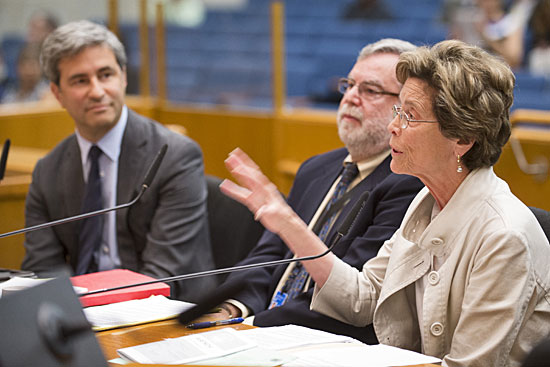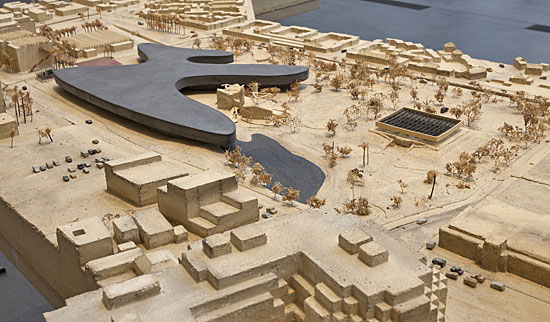LACMA redesign to respect tar pits
September 26, 2013

Jane Pisano of the Natural History Museum addresses supervisors, as LACMA's Michael Govan, far left, and James Gilson of NHM look on.
Leaders of the Los Angeles County Museum of Art and Natural History Museum are pledging to work together to make sure that a proposed new signature building on the LACMA campus doesn’t harm the landmark La Brea Tar Pits.
Preliminary plans for the new art gallery, to be designed by Pritzker Prize-winning architect Peter Zumthor, were unveiled this summer as part of LACMA’s “Presence of Past” exhibition, which showcased the architect’s concepts for transforming the museum campus.
The Swiss architect’s proposal calls for a largely transparent gallery—allowing passersby to view art through glass even without entering the museum—built in a curving shape reminiscent of the tar pits on the site.
But concerns about those tar pits quickly bubbled up after an early model and design were put on public display.
Officials of the Natural History Museum and its Page Museum, which oversees the Pleistocene era fossil-rich tar pits as an active scientific research site as well as a public attraction, were worried about the impact of the proposed LACMA construction.
On Tuesday, leaders of LACMA and the Natural History Museum came together to inform the Board of Supervisors that they are committed to working together to make sure the tar pits are protected.
“We can guarantee that there will not be a significant impact on the La Brea Tar Pits as we develop the plan,” Michael Govan, LACMA’s director and CEO, told the supervisors. He added that the design, now in its “earliest stages,” is meant not only to improve LACMA but also to create better access to the Page Museum and the tar pits that share the Hancock Park site, which he said would end up with an additional 1.2 acres of ground space. A cantilevered section of the design over the tar pit lake bed already is being altered in response to concerns, Govan said.
Jane Pisano, the Natural History Museum’s president and director, noted that LACMA’s plan is still “very preliminary and fluid, and if there is a negative impact on the tar pits, the design can and will be adjusted to protect them. This is something that Michael has said many times, and we take him at his word.”
However, she added, there are challenges ahead.
“Preliminary review of the plans for the building indicate that it would severely impact six of the nine tar pits in the park,” she said.
“So, early days, we know we have a lot of work to do. But we are assured that it is early days,” Pisano said. She said the early collaboration is essential to ensure that this “world-renowned destination” and unique scientific resource isn’t harmed.
“Ice Age fossils and micro fauna trapped in the tar below the surface provide invaluable information about life thousands of years ago, as well as possible clues for climate change and habitat in the future,” Pisano said.
Both parties said they are continuing to work with the county’s Chief Executive Office in the coming weeks to develop a memorandum of understanding to help them chart the course ahead. If the project is approved by LACMA’s board of trustees, the museum would undertake a two-year feasibility study. Construction would not begin until sometime after a new motion picture museum opens on the campus in 2017.
Govan said that the project presents LACMA with a unique opportunity to be a leader in reimagining how an encyclopedic museum can be structured.
“It has a plan that will be more accessible to the public than I think any that’s been designed anywhere in the world to date,” he said. “And that’s one of the exciting opportunities of a museum in a park.”
Doing nothing is not an option, he added, given the deteriorating state of the four buildings that would be replaced by the new structure.
Just bringing those buildings up to code would cost $317 million, he said. Early construction cost estimates for the new building range from $400 million to $450 million—costs that would be offset by significant energy savings from the building’s solar panels and by an increase in visitors to the museum, he said.
Supervisor Zev Yaroslavsky said that he was “not overly thrilled’ by the design at first, but has come to see it as a “stroke of genius.”
“This is a controversial plan architecturally. Any decent architectural plan is going to be controversial. If there’s no controversy, it isn’t worth the paper it’s written on.”
“Being able to build your project without doing any damage to the tar pits and the scientific research that continues to be done there is a no-brainer,” Yaroslavsky said. “There is room enough on that campus for both the tar pits and for the museum. And that’s the way it’s going to have to be.”

Architect Peter Zumthor's initial vision for LACMA shows a cantilever over tar pit lake bed. That element has since been altered. Photo/LACMA
Posted 9/25/13














 405 bridge work causes a stink
405 bridge work causes a stink